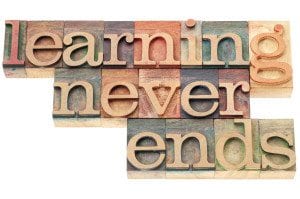MBTI® Personality Test and Learning Styles
Humans are hardwired to learn constantly, in every environment and at every age. However, different people have different learning styles and learn best in different ways. Some prefer to absorb information by quietly reading, while others prefer processing information by talking with others, or by trying to apply the information to accomplish a task. Knowing how you learn best and mastering key learning styles strategies can help you learn better and faster, no matter what your goals are or what stage of your life you are in. This series of blogs focuses on learning styles, and will help you develop strategies for studying smart, rather than hard, and begin to become an even more efficient, well-rounded learner.
The first step is understanding your Myers-Briggs® Personality Test Type (MBTI® Test), a measure developed by Katharine Cook Briggs and Isabel Briggs Myers, and heavily influenced by the work of Carl Jung. Your MBTI® Type influences every aspect of your personality, from decision-making to leadership, even learning styles! In this series of blogs, we will utilize information from MBTI® research to provide valuable insights into how you prefer to learn, including how you process and absorb information most efficiently, what classroom environments best suit your learning style, how you tend to relate to your peers and instructors, and finally learning strategies that may help you learn even more effectively.

Learn about MBTI® Learning Styles in this 16 part blog series
While learning styles and specific techniques vary widely, Dunning (2008) identifies several global considerations that will benefit all learners. One of the most important factors in successful learning is motivation. Motivated learners almost always outperform those who are unmotivated. To keep the juices flowing, whether you are tackling a large project or running a marathon, it may be helpful to jot down your final goal, why it matters, and perhaps a few intermediate benchmarks. Having these benchmarks will also help you more effectively identify priorities and manage your time and resources in meeting them. Smart learners know how to prioritize, and value higher-urgency or higher-payoff items above those that are less urgent or have a lower return on investment. In order to reduce distractions and focus, many learners find it helpful to identify a learning space and curate it to meet their needs, whether it is a quiet corner of an office, or a livelier coffee shop. Different people learn best in different environments, so don’t be afraid to experiment and find something that works for you.
Now that you have set priorities and the perfect environment, it’s time to focus on strategies for learning itself. All learning material, from books to online courses to lectures, has a logic of organization. Before you begin actively studying, take a few minutes to get the lay of the land—read headings, and familiarize yourself with graphs and images. As you read, ask yourself analytical questions, and remember, highlight at most 10% of the content. If you highlight everything, nothing stands out. You may also find it helpful to come up with your own way of organizing material, for instance in making an outline or flash cards, or in designing graphic organizers. Again, learn your way. What works for a friend may not be as successful for you, and vice versa. There is no right or wrong way to learn; there are just ways that work and don’t work for different people.
If you are preparing for a specific exam, prepare to perform. In other words, practice in the way you will be assessed. If you have a written exam coming up, practice writing essays. If you have to give an oral presentation, have a friend listen to your lecture. Completing practice tests will also allow you to track your progress, even if only on scrap paper. If something works for you, fantastic! Keep doing it. If it doesn’t, tweak your strategies until you find your optimal performance. Whether you are an outgoing, hands-on learner, or prefer to quietly read a book, think about what strategies you use in your own learning, and how you can employ them even more effectively.
In this 16 part series, we will explore in detail each of the 16 MBTI® learning styles, their proclivities, and their areas for growth. Different individuals clearly learn in different ways, but with an understanding of how you yourself and your peers learn best, you can work to structure your own and others’ learning environments in ways that benefit everyone.
Formulate a career path that you’ll enjoy for years to come with the help of the Strong Interest Inventory test below:
-
Strong Interest Inventory® & Skills Confidence Profile + Strong Interpretive Report
Price: $72.95 Buy NowDIGITAL DELIVERY
- Better understand your strengths, interests, preferences, and areas of confidence
- Connect your innate traits to a successful and satisfying career
- Links to complete assessments are sent digitally via email within 2-3 business hours of purchase
- Results sent in PDF form via email within 6-8 business hours
Download sample Strong Interest Inventory® & Skills Confidence Profile + Strong Interpretive Report
Discover occupations that work with what you like and enjoy, and learn how your personality influences your mental processes and preferences with the combination test below:
Click on a link below to read more about different MBTI Personality Types
| ISTJ | ISFJ | INFJ | INTJ | ESTP | ESFP | ENFP | ENTP |
| ISTP | ISFP | INFP | INTP | ESTJ | ESFJ | ENFJ | ENTJ |
Reference
Introduction To Type and Learning. (Dunning, D, 2008. CPP)

